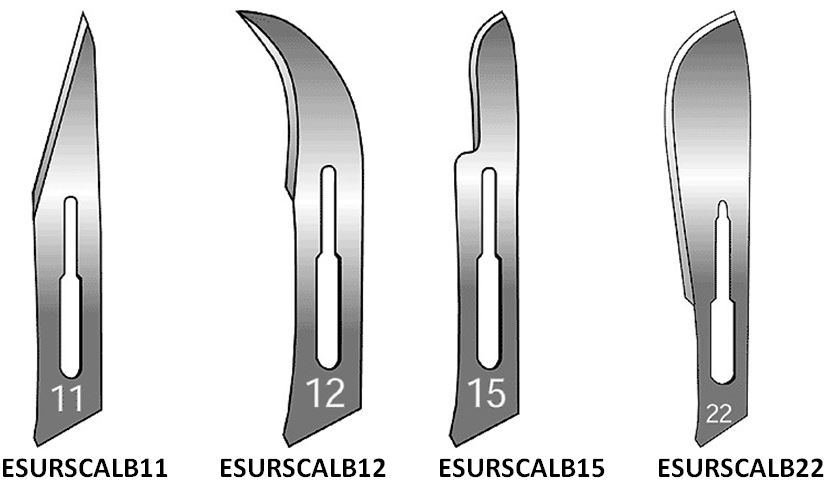(scalpel nº 4) BLADE, s.u., sterile, nº 22, 01-22-22
Valid Article
Scalpel blade, disposable
Definition
A sterile interchangeable device designed to mount a compatible handle and function as the cutting edge of a scalpel. The device is made of high-grade stainless steel alloy and is used as a surgical instrument to cut and dissect tissues.
Specifications
Technical specifications
- Sterile, single use item
- Blades are manufactured with a corresponding fitment size so that they fit on only handles with the same fitment.
- Material: martensitic steel
- Hardness: 50 to 58 HRC (Hardness Rockwell Scale C)
- The number indicates the shape of the blade
- Length of the blade :
- Blade nr 11 : 40 mm
- Blade nr 12 : 38 mm
- Blade nr 15 : 38 mm
- Blade nr 22 : 57 mm
- Blade No. 11 - is an elongated triangular blade sharpened along the hypotenuse edge and with a strong pointed tip making it ideal for stab incisions. The No.11 blades fit handles 3, 3L, 3 Graduated, 5B, 7, 9, B3 and B3L.
- Blade No. 12 - is a small, pointed, crescent shaped blade sharpened along the inside edge of the curve. It is sometimes utilised as a suture cutter. The No.12 fits handles 3, 3L, 3 Graduated, 5B, 7, 9, B3 and B3L.
- Blade No. 15 - has a small curved cutting edge and is the most popular blade shape ideal for making short and precise incisions. The No.15 fits handles 3, 3L, 3 Graduated, 5B, 7, 9, B3 and B3L.
- Blade No.22 is a large version of the No.10 blade with a curved cutting edge and an unsharpened back edge. No.22 fits handles 4, 4L, 4 Graduated & 6B
Packaging & Labelling
Aluminium-laminated individual sterile packaging.
Packaged per 100.
Instructions for use
Single use only
To prevent any risk of injury, use forceps to fit the blade on the handle and to remove it.
When removing a blade form the protective packet make sure it is not dropped into a metal bowl or container as this can reduce the initial keenness of the cutting edge even before it is fitted to the handle. If you have to use forceps or needle holders to remove the blade from its protective packet ensure that you do not grip the blade across the cutting edge.
Keep a sufficient stock.
Waste management
Immediately after use, dispose of the soiled blade into a sharps container (see related articles below).
(Cf Public Health Engineering In Precarious Situations, MSF, 2010, Chapter 6)





![[KMEDMHHS21-] (mod hospital) SMALL RENEWABLE SUPPLIES 2015](/web/image/product.template/572822/image_256/%5BKMEDMHHS21-%5D%20%28mod%20hospital%29%20SMALL%20RENEWABLE%20SUPPLIES%20%202015?unique=4e99d96)
![[KMEDMHOS21-] (mod OT Room) SMALL RENEWABLE SUPPLIES 2015](/web/image/product.template/572854/image_256/%5BKMEDMHOS21-%5D%20%28mod%20OT%20Room%29%20SMALL%20RENEWABLE%20SUPPLIES%20%202015?unique=831960c)
![[KMEDMSUP04S1] (supplementary unit 2018) MODULE RENEWABLE SUPPLIES 2019](/web/image/product.template/569226/image_256/%5BKMEDMSUP04S1%5D%20%28supplementary%20unit%202018%29%20MODULE%20RENEWABLE%20SUPPLIES%202019?unique=c28d635)
![[KMEDMSUT1--] MODULE, SUTURE EQUIPMENT](/web/image/product.template/569065/image_256/%5BKMEDMSUT1--%5D%20MODULE%2C%20SUTURE%20EQUIPMENT?unique=1da3daf)
![[KMEDMHCS11-] (mod OPD) SMALL RENEWABLE SUPPLIES](/web/image/product.template/572699/image_256/%5BKMEDMHCS11-%5D%20%28mod%20OPD%29%20SMALL%20RENEWABLE%20SUPPLIES?unique=c689d75)
![[KMEDMSUP05S] (IEHK 2024 suppl. module) SUPPLEMENTARY RENEWABLE UNIT](/web/image/product.template/583185/image_256/%5BKMEDMSUP05S%5D%20%28IEHK%202024%20suppl.%20module%29%20SUPPLEMENTARY%20RENEWABLE%20UNIT?unique=9fce31f)
![[KMEDKFAI5RS] MOBILE MEDICAL BAG KIT, rucksack](/web/image/product.template/572106/image_256/%5BKMEDKFAI5RS%5D%20MOBILE%20MEDICAL%20BAG%20KIT%2C%20rucksack?unique=3676d20)
![[ESURSCAL4--] SCALPEL HANDLE, nº4 standard 01-28-04](/web/image/product.template/569763/image_256/%5BESURSCAL4--%5D%20SCALPEL%20HANDLE%2C%20n%C2%BA4%20standard%2001-28-04?unique=10b5d7b)
![[ESURSCAL4L-] SCALPEL HANDLE, nº4 long 01-28-14](/web/image/product.template/569777/image_256/%5BESURSCAL4L-%5D%20SCALPEL%20HANDLE%2C%20n%C2%BA4%20long%2001-28-14?unique=c85def6)
![[SINSCONT1R-] REUSABLE SHARPS CONTAINER (RSC), 1.2 litre](/web/image/product.template/569744/image_256/%5BSINSCONT1R-%5D%20REUSABLE%20SHARPS%20CONTAINER%20%28RSC%29%2C%201.2%20litre?unique=95272d3)